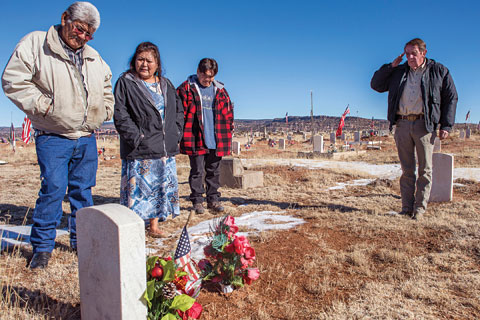 |
||||||||||||
|
July/August 2014 Ed Ryan and Joe Etsitty:
BY VIDA VOLKERT Ed Ryan knew him as “Joe.” That’s how Van Etsitty, a slim Navajo man from Mariano Lake, New Mexico, introduced himself to his squad leader forty-five years ago. He was a quiet 27-year-old who liked to draw in his free time and could easily fall asleep in the middle of the jungle—like the night the squad was on patrol and took a half-hour break. They were very tired, Ryan remembered, and sat down in thick brush. It was dark, warm, and humid. The men had to be quiet to avoid detection. Then they got up and walked for a quarter mile before realizing they had left Etsitty behind. “We had to go back,” Ryan said. “We found him asleep. How do you sneak up on an Indian? I knew he would wake up and start shooting. I was careful to put my foot on his gun barrel.” That story still makes Ryan laugh. But when he talked about what followed a few months later, his voice cracked. “We lived an extreme life,” he said. “Vietnam was hours and hours of terrible boredom, with pieces of intense fear. We went from one extreme to the other. It could happen in a heartbeat, and you didn’t know when that heartbeart was going to be.” For Etsitty, that heartbeat happened June 1, 1968. Ryan’s squad was sent out to support a unit that had been dropped by mistake in the middle of an enemy camp. The squad was in a helicopter when they caught enemy fire. Etsitty was the radio operator that day. “We were catching so much fire. When we circled around, Joe was still there,” Ryan said. “We were fifty feet off the ground when they nailed him. That’s the last time I saw him. We left his body on the chopper. Ryan, who belongs to Riverside, California, Chapter 47, told his story to members of Etsitty’s family on a winter morning in the lobby of the Gallup Econo Lodge. A forensic psychologist, Ryan had traveled to New Mexico forty-five years after Etsitty’s death to meet his family, visit his grave in Fort Defiance, and find closure. Van Etsitty was the only man Ryan lost in Vietnam. “He died immediately,” Ryan told his brother, Dan. Ryan and the family drove to the veterans cemetery in Fort Defiance that afternoon and visited his grave, something Ryan had wanted to do for decades. During a Christmas dinner later that day, Ryan was given a painting Etsitty had completed before he went to Vietnam. In Etsitty’s interpretation of “The End of the Trail” a Native American warrior is sitting on a blue horse. The horse’s color and the downcast warrior evoked sadness in Ryan. But Jackson Gibson, who served as the link between the Etsitty family and Ryan, explained that in the Navajo creation myth the first people climbed from a world of darkness to the blue world, and that horses are sacred. Ryan was enthralled, absorbing as much as he could about the world of his late squad member, who seemed very much alive in the memories of his relatives. At times he could see him in some of the men, particularly the quiet ones. The Christmas tree in the corner of the room was decorated with a variety of pinecones. Under the tree were “boxes of gifts, and those gifts were wrapped in plain brown bags,” Ryan said. “I opened my bag and it was all nuts. Different kinds of nuts. Well, I thought a lot about that. They are proud people, and their gifts sustain people rather than some kind of bauble.”
|
||||||||||||
|
|
||||||||||||
|
||||||||||||
8719 Colesville Road, Suite 100, Silver Spring. MD 20910 | www.vva.org | contact us |
||||||||||||









